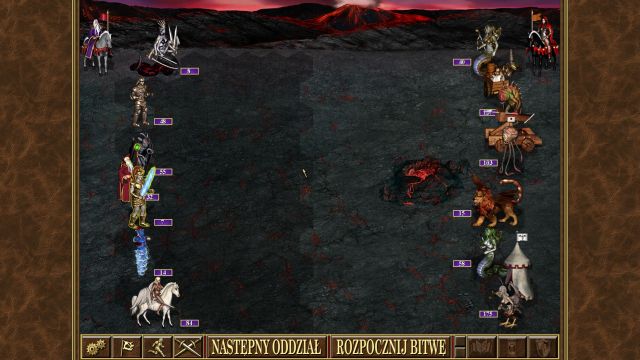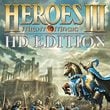Heroes 3 HD Edition: Combat

Combat in Heroes of Might & Magic 3 HD is based on turn-based system, but not like in the other RPG games, when it works like "the first one to move is the X player, after which the Y player makes his move". Here the order of the movement is strictly connected with the Speed attribute of units - the higher the speed is, the faster (and further) the unit will move. It replaced the "initiative" attribute, which was present in the earlier installments of the series. The order of movements can also be influenced by certain artifacts and spells, such as Haste, Prayer and Slow, which increase or decrease speed, or Blind, which prevents movement.
Combat can be divided into two kinds: against neutral monsters or versus other players (cpu-controlled or a living player). The difference, despite appearances, is quite significant, as the enemy hero has a huge influence on the abilities of units under his command, and the appropriate amount of Power and Knowledge attributes will allow the hero to turn the tides of every battle.
The whole combat stats from attacking the monster / other hero by another hero - the action is moved to a small battlefield, divided into net-like fields (hexes), representing places in which units can be placed. The speed attribute, which influences the order of movement, determines the range of a unit as well - a unit with 10 points of speed will be able to cover a distance of 10 hexes. The whole battlefield is 15 hexes wide and 11 hexes tall. Additionally, terrain obstacles main appear on the battlefield, severely limiting, or even preventing movement in a given direction. Most of the units present in the game take 1 hex, but some of them can be 2 hexes wide.
Besides that, there's an interface bar present on the screen, which allows you to control various gameplay mechanics, such as:
- Combat options - after clicking on it, a screen will appear, allowing you to adjust combat-related options, such as the animation speed of units, whether or not you want to be able to see a movement grid, and so on.
- An option to surrender - an option which allows you to surrender during combat. A hero who decides to surrender must pay a "penalty toll", which is a part of the total price of his units. The advantage of such a process is the fact, that you can hire the hero at the Inn and he will have all the army he surrendered with.
- An option to flee - after activating it, the hero will flee the battlefield, leaving all the units behind. You don't have to pay a penny for that, and you can recruit the hero, along with his experience and artifacts back at the Inn, but without the army he had.
- Automatic combat - an "autopilot" option. After activating it, your army will be controlled by a computer player - it's a bad idea to activate it, as the computer controlled player tend to make some irrational decisions, which may cost you lots of units.
- Dialog Box - this window is stationed at the bottom, center part of the screen. There you can find all the important information about the course of the battle, such as the amount of damage dealt by various creatures, events that happened during the battle (low/high morale effects), and so on.
- Spellbook - it allows you to gain access to spells at the heroes' disposal. You now have to click on the spell and select the target and it will be cast.
- The option to "Wait" - it allows your unit to save its move for a better moment (the end of the round). After all the other units have moved, the time comes for the ones that used the "wait" option.
- The option to "Defend" - your unit will waste a turn, but in return it will be given a significant boost to its defense attribute. It comes in handy when you don't want to move your unit.
The battle is won by the "last standing" enemy - the one who loses all the units is the one to lose. After the battle ends, the victor receives experience points and any artifacts that the defeated hero had in his inventory.
- Heroes of Might & Magic III: HD Edition Game Guide
- Heroes 3 HD Edition: Game Guide
- Heroes 3 HD Edition: Information about gameplay
- Heroes 3 HD Edition: Combat
- Heroes 3 HD Edition: Movement around the map
- Heroes 3 HD Edition: Magic
- Heroes 3 HD Edition: Fire Magic
- Heroes 3 HD Edition: Air Magic
- Heroes 3 HD Edition: Water Magic
- Heroes 3 HD Edition: Earth Magic
- Heroes 3 HD Edition: Artifacts
- Heroes 3 HD Edition: Left and Right Hand
- Heroes 3 HD Edition: Torso and Head
- Heroes 3 HD Edition: Feet, Neck, Hands, Shoulders
- Heroes 3 HD Edition: Other
- Heroes 3 HD Edition: Achievements
- Heroes 3 HD Edition: System requirements
- Heroes 3 HD Edition: Information about gameplay
- Heroes 3 HD Edition: Game Guide
You are not permitted to copy any image, text or info from this page. This site is not associated with and/or endorsed by the developers and the publishers. All logos and images are copyrighted by their respective owners.
Copyright © 2000 - 2025 Webedia Polska SA for gamepressure.com, unofficial game guides, walkthroughs, secrets, game tips, maps & strategies for top games.
